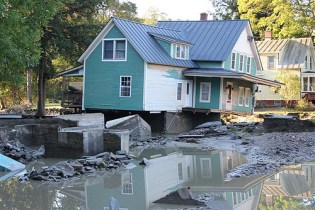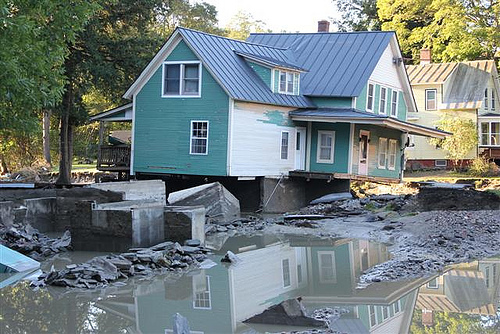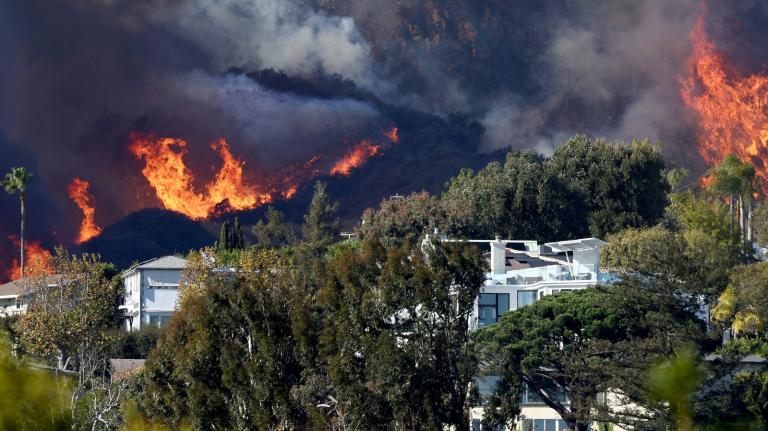
The Northeast could not have recovered as quickly from Hurricane Irene without the help of the federal government. (Photo by U.S. Fish and Wildlife Service.)
This essay was originally published on TomDispatch and is republished here with Tom’s kind permission.
Look back on 2011 and you’ll notice a destructive trail of extreme weather slashing through the year. In Texas, it was the driest year ever recorded. An epic drought there killed half a billion trees, touched off wildfires that burned 4 million acres, and destroyed or damaged thousands of homes and buildings. The costs to agriculture, particularly the cotton and cattle businesses, are estimated at $5.2 billion — and keep in mind that, in a winter breaking all sorts of records for warmth, the Texas drought is not yet over.
In August, the East Coast had a close brush with calamity in the form of Hurricane Irene. Luckily, that storm had spent most of its energy by the time it hit land near New York City. Nonetheless, its rains did at least $7 billion worth of damage, putting it just below the $7.2 billion worth of chaos caused by Katrina back in 2005.
Across the planet the story was similar. Wildfires consumed large swaths of Chile. Colombia suffered its second year of endless rain, causing an estimated $2 billion in damage. In Brazil, the life-giving Amazon River was running low due to drought. Northern Mexico is still suffering from its worst drought in 70 years. Flooding in the Thai capital, Bangkok, killed over 500 and displaced or damaged the property of 12 million others, while ruining some of the world’s largest industrial parks. The World Bank estimates the damage in Thailand at a mind-boggling $45 billion, making it one of the most expensive disasters ever. And that’s just to start a 2011 extreme-weather list, not to end it.
Such calamities, devastating for those affected, have important implications for how we think about the role of government in our future. During natural disasters, society regularly turns to the state for help, which means such immediate crises are a much-needed reminder of just how important a functional big government turns out to be to our survival.
These days, big government gets big press attention — none of it anything but terrible. In the United States, especially in an election year, it’s become fashionable to beat up on the public sector and all things governmental (except the military). The right wing does it nonstop. All their talking points disparage the role of an oversized federal government. Anti-tax zealot Grover Norquist famously set the tone for this assault. “I’m not in favor of abolishing the government,” he said. “I just want to shrink it down to the size where we can drown it in the bathtub.” He has managed to get 235 members of the House of Representatives and 41 members of the Senate to sign his “Taxpayer Protection Pledge” and thereby swear never, under any circumstances, to raise taxes.
By now, this viewpoint has taken on the aura of folk wisdom, as if the essence of democracy were to hate government. Even many on the left now regularly dismiss government as nothing but oversized, wasteful, bureaucratic, corrupt, and oppressive, without giving serious consideration to how essential it may be to our lives.
But don’t expect the present “consensus” to last. Global warming and the freaky, increasingly extreme weather that will accompany it is going to change all that. After all, there is only one institution that actually has the capacity to deal with multi-billion-dollar natural disasters on an increasingly routine basis. Private security firms won’t help your flooded or tornado-struck town. Private insurance companies are systematically withdrawing coverage from vulnerable coastal areas. Voluntary community groups, churches, anarchist affinity groups — each may prove helpful in limited ways, but for better or worse, only government has the capital and capacity to deal with the catastrophic implications of climate change.
Consider Hurricane Irene: As it passed through the Northeast, states mobilized more than 100,000 National Guard troops. New York City opened 78 public emergency shelters prepared to house up to 70,000 people. In my home state, Vermont, where the storm devastated the landscape, destroying or damaging 200 bridges, more than 500 miles of road, and 100 miles of railroad, the National Guard airlifted in free food, water, diapers, baby formula, medicine, and tarps to thousands of desperate Vermonters trapped in 13 stranded towns — all free of charge to the victims of the storm.
The damage to Vermont was estimated at up to $1 billion. Yet the state only has 621,000 residents, so it could never have raised all the money needed to rebuild alone. Vermont businesses, individuals, and foundations have donated at least $4 million, possibly up to $6 million in assistance, an impressive figure, but not a fraction of what was needed. The state government immediately released $24 million in funds, crucial to getting its system of roads rebuilt and functioning, but again that was a drop in the bucket, given the level of damage. A little known state-owned bank, the Vermont Municipal Bond Bank, also offered low-interest, low-collateral loans to towns to aid reconstruction efforts. But without federal money, which covered 80 to 100 percent of the costs of rebuilding many Vermont roads, the state would still be an economic basket case. Without aid from Washington, the transportation network might have taken years to recover.
As for flood insurance, the federal government is pretty much the only place to get it. The National Flood Insurance Program has written 5.5 million policies in more than 21,000 communities covering $1.2 trillion worth of property. As for the vaunted private market, for-profit insurance companies write between 180,000 and 200,000 policies [PDF] in a given year. In other words, that is less than 5 percent of all flood insurance in the United States. This federally subsidized program underwrites the other 95 percent. Without such insurance, it’s not complicated: Many waterlogged victims of 2011, whether from record Midwestern floods or Hurricane Irene, would simply have no money to rebuild.
Or consider sweltering Texas. In 2011, firefighters responded to 23,519 fires. In all, 2,742 homes were destroyed by out-of-control wildfires. But government action saved 34,756 other homes. So you decide: Was this another case of wasteful government intervention in the marketplace, or an extremely efficient use of resources?
Facing snowpocalypse without plows
The early years of this century have already offered a number of examples of how disastrous too little government can be in the face of natural disaster, Katrina-inundated New Orleans in 2005 being perhaps the quintessential case.
There are, however, other less noted examples that nonetheless helped concentrate the minds of government planners. For example, in the early spring of 2011, a massive blizzard hit New York City. Dubbed “snowmageddon” and “snowpocalypse,” the storm arrived in the midst of tense statewide budget negotiations, and a nationwide assault on state workers (and their pensions).
In New York, Mayor Mike Bloomberg was pushing for cuts to the sanitation department budget. As the snow piled up, the people tasked with removing it — sanitation workers — failed to appear in sufficient numbers. As the city ground to a halt, New Yorkers were left to fend for themselves with nothing but shovels — their cars, doorways, stores, roads all hopelessly buried. Chaos ensued. Though nowhere near as destructive as Katrina, the storm became a case study in too little governance and the all-too-distinct limits of “self-reliance” when nature runs amok. In the week that followed, even the rich were stranded amid the mounting heaps of snow and uncollected garbage.
Bloomberg emerged from the debacle chastened, even though he accused the union of staging a soft strike, a work-to-rule-style slowdown that held the snowbound city hostage. The union denied engaging in any such illegal actions. Whatever the case, the blizzard focused thinking locally on the nature of public workers. It suddenly made sanitation workers less invisible and forced a set of questions: Are public workers really “union fat cats” with “sinecures” gorging at the public trough? Or are they as essential to the basic functions of the city as white blood cells to the health of the human body? Clearly, in snowbound New York it was the latter. No sanitation workers and your city instantly turns chaotic and fills with garbage, leaving street after street lined with the stuff.
More broadly the question raised was: Can an individual, a town, a city, even a state really “go it alone” when the weather turns genuinely threatening? Briefly, all the union bashing and attacks on the public sector that had marked that year’s state-level budget debates began to sound unhinged.
In the Big Apple at least, when Irene came calling that August, Bloomberg was ready. He wasn’t dissing or scolding unions. He wasn’t whining about the cost of running a government. He embraced planning, the public sector, public workers, and coordinated collective action. His administration took unprecedented steps like shutting down the subway and moving its trains to higher ground. Good thing they did. Several low-lying subway yards flooded. Had trains been parked there, many millions in public capital might have been lost or damaged.
The secret history of free enterprise in America
When thinking about the forces of nature and the nature of infrastructure, a slightly longer view of history is instructive. And here’s where to start: In the U.S., despite its official pro-market myths, government has always been the main force behind the development of a national infrastructure, and so of the country’s overall economic prosperity.
One can trace the origins of state participation in the economy back to at least the founding of the republic: from Alexander Hamilton’s First Bank of the United States, which refloated the entire post-revolutionary economy when it bought otherwise worthless colonial debts at face value; to Henry Clay’s half-realized program of public investment and planning called the American System; to the New York State-funded Erie Canal, which made the future Big Apple the economic focus of the eastern seaboard; to the railroads, built on government land grants, that took the economy west and tied the nation together; to New Deal programs that helped pulled the country out of the Great Depression and built much of the infrastructure we still use, like the Hoover Dam, scores of major bridges, hospitals, schools, and so on; to the government-funded and sponsored interstate highway system launched in the late 1950s; to the similarly funded space race, and beyond. It’s simple enough: Big government investments (and thus big government) have been central to the remarkable economic dynamism of the country.
Government has created roads, highways, railways, ports, the postal system, inland waterways, universities, and telecommunications systems. Government-funded research and development, as well as the buying patterns of government agencies — alas, both often connected to war and war-making plans — have driven innovation in everything from textiles and shipbuilding to telecoms, medicine, and high-tech breakthroughs of all sorts. Individuals invent technology, but in the United States it is almost always public money that brings the technology to scale, be it in aeronautics, medicine, computers, or agriculture.
Without constant government planning and subsidies, American capitalism simply could not have developed as it did, making ours the world’s largest economy. Yes, the entrepreneurs we are taught to venerate have been key to all this, but dig a little deeper and you soon find that most of their oil was on public lands, their technology nurtured or invented thanks to government-sponsored R&D, or supported by excellent public infrastructure and the possibility of hiring well-educated workers produced by a heavily subsidized higher-education system. Just to cite one recent example, the now-familiar Siri voice-activated command system on the new iPhone is based on — brace yourself — government-developed technology.
And here’s a curious thing: Everybody more or less knows all this, and yet it is almost never acknowledged. If one were to write the secret history of free enterprise in the United States, one would have to acknowledge that it has always been and remains at least a little bit socialist. However, it’s not considered proper to discuss government planning in open, realistic, and mature terms, so we fail to talk about what government could — or rather, must — do to help us meet the future of climate change.
Storm socialism
The onset of ever more extreme and repeated weather events is likely to change how we think about the role of the state. But attitudes toward the Federal Emergency Management Agency (FEMA), which stands behind state and local disaster responses, suggest that we’re hardly at that moment yet. In late 2011, with Americans beleaguered by weather disasters, FEMA came under attack from congressional Republicans, eager to starve it of funds. One look at FEMA explains why.
Yes, when George W. Bush put an unqualified playboy at its helm, the agency dealt disastrously with Hurricane Katrina back in 2005. Under better leadership, however, it has been anything but the sinister apparatus of repression portrayed by legions of rightists and conspiracy theorists. FEMA is, in fact, an eminently effective mechanism for planning focused on the public good, not private profit, a form of public insurance and public assistance for Americans struck by disaster. Every year FEMA gives hundreds of millions of dollars to local firefighters and first responders, as well as victims dealing with the aftershock of floods, fires, and the other calamities associated with extreme weather events.
The agency’s work is structured around what it calls “the disaster life cycle” — the process through which emergency managers prepare for, respond to, and help others recover from and reduce the risk of disasters. More concretely, FEMA’s services include training, planning, coordinating, and funding state and local disaster managers and first responders, grant-making to local governments, institutions, and individuals, and direct emergency assistance that ranges from psychological counseling and medical aid to emergency unemployment benefits. FEMA also subsidizes long-term rebuilding and planning efforts by communities affected by disasters. In other words, it actually represents an excellent use of your tax dollars to provide services aimed at restoring local economic health and so the tax base. The anti-government right hates FEMA for the same reason that they hate Social Security — because it works!
As it happens, thanks in part to the congressional GOP’s sabotage efforts, thousands of FEMA’s long-term recovery projects are now on hold, while the cash-strapped agency shifts its resources to deal with only the most immediate crises. This represents a dangerous trend, given what historical statistics tell us about our future. In recent decades, the number of Major Disaster Declarations by the federal government has been escalating sharply: only 12 in 1961, 17 in 1971, 15 in 1981, 43 in 1991, and in 2011 — 99! As a result, just when Hurricane Irene bore down on the East Coast, FEMA’s disaster relief fund had already been depleted from $2.4 billion as the year began to a mere $792 million.
Like it or not, government is a huge part of our economy. Altogether, federal, state, and local government activity — that is, collecting fees, taxing, borrowing and then spending on wages, procurement, contracting, grant-making, subsidies, and aid — constitutes about 35 percent of the gross domestic product. You could say that we already live in a somewhat “mixed economy”: that is, an economy that fundamentally combines private and public economic activity.
The intensification of climate change means that we need to acknowledge the chaotic future we face and start planning for it. Think of what’s coming, if you will, as a kind of storm socialism.
After all, climate scientists believe that atmospheric concentrations of carbon dioxide beyond 350 parts per million (ppm) could set off compounding feedback loops and so lock us into runaway climate change. We are already at 392 ppm. Even if we stopped burning all fossil fuels immediately, the disruptive effect of accumulated CO2 in the atmosphere is guaranteed to hammer us for decades. In other words, according to the best-case scenario, we face decades of increasingly chaotic and violent weather.
In the face of an unraveling climate system, there is no way that private enterprise alone will meet the threat. And though small “d” democracy and “community” may be key parts of a strong, functional, and fair society, volunteerism and “self-organization” alone will prove as incapable as private enterprise in responding to the massive challenges now beginning to unfold.
To adapt to climate change will mean coming together on a large scale and mobilizing society’s full range of resources. In other words, big storms require big government. Who else will save stranded climate refugees, or protect and rebuild infrastructure, or coordinate rescue efforts and plan out the flow and allocation of resources?
It will be government that does these tasks or they will not be done at all.



